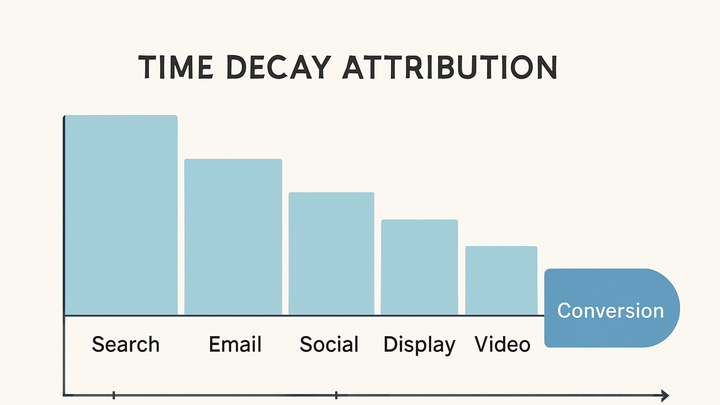Published on 2025-06-26T04:30:31Z
What is Time-Decay Attribution? Examples and Benefits
Time-Decay Attribution is a multi-touch model in marketing analytics that allocates conversion credit across every customer interaction, giving more weight to those closest in time to the conversion. Unlike last-touch or first-touch models, it accounts for the entire journey while emphasizing the critical impact of recent touchpoints. This approach uses an exponential decay function to reduce the influence of earlier interactions gradually. Platforms like Google Analytics 4 and cookie-free solutions such as PlainSignal support time-decay attribution, enabling teams to measure and optimize their campaigns more effectively. By visualizing how each touchpoint’s influence decreases over time, marketers can better understand channel performance and refine budget allocation. Time-decay attribution combines depth of insight with practical application to drive more informed decision-making.
Time-decay attribution
Model that allocates conversion credit across touchpoints, weighting those closer in time to conversion more heavily.
How Time-Decay Attribution Works
Time-decay attribution weights each touchpoint based on recency using an exponential decay function. The closer an interaction is to the conversion event, the higher its assigned credit. Typically, you configure a half-life (e.g., 7 days) to control how fast earlier touchpoints lose influence. Both GA4 and PlainSignal allow you to set or simulate these decay parameters to suit your purchase cycles.
-
Decay settings
Define a half-life period to determine how quickly credit decreases for earlier touchpoints. A shorter half-life emphasizes recent interactions more strongly.
-
Credit allocation formula
Apply an exponential decay formula: weight = 0.5^(time since interaction ÷ half-life). Normalize these weights so they sum to 1 and multiply by the conversion value.
-
Implementation in google analytics 4
GA4 uses data-driven attribution by default but lets you compare models, including time-decay, in the Attribution Settings. You can customize lookback windows and half-life parameters to reflect your sales cycle.
-
Implementation in PlainSignal
PlainSignal’s attribution settings support custom time-decay models in a cookie-free environment. Install the snippet below to start collecting events and apply your decay rules in the dashboard:
-
PlainSignal tracking snippet
<link rel="preconnect" href="//eu.plainsignal.com/" crossorigin /> <script defer data-do="yourwebsitedomain.com" data-id="0GQV1xmtzQQ" data-api="//eu.plainsignal.com" src="//cdn.plainsignal.com/plainsignal-min.js"></script>
-
Benefits of Time-Decay Attribution
By blending full-journey visibility with a focus on recency, time-decay attribution helps teams make smarter budget and channel decisions. It bridges the gap between single-touch simplicity and complex probabilistic models.
-
Balanced credit
Distributes credit across all touchpoints, acknowledging both early awareness efforts and last-step drivers.
-
Emphasis on recency
Highlights channels and campaigns that most directly influence the final conversion decision.
-
Actionable insights
Reveals which touchpoints deliver the highest impact near conversion, guiding optimizations and spend allocation.
Limitations and Considerations
While more nuanced than single-touch models, time-decay attribution still relies on certain assumptions and data quality. Marketers should evaluate whether its recency bias aligns with their customer journey characteristics.
-
Model complexity
Requires accurate timestamps for every interaction and careful tuning of decay parameters, which can be resource-intensive.
-
Recency bias assumption
Assumes that more recent interactions always have greater impact, which may not hold in all industries or long-consideration purchases.
-
Data volume requirements
Needs sufficient interaction data to produce stable weight distributions, potentially challenging for smaller sites or low-traffic campaigns.
Practical Examples and Use Cases
Here are scenarios where time-decay attribution can unlock strategic value, illustrated with GA4 and PlainSignal implementations.
-
B2b lead nurturing
In long sales cycles, early touchpoints like whitepaper downloads get some credit, but demo requests and webinar registrations just before conversion carry more weight.
-
E-commerce retargeting
Track how site visits and cart reminders drive purchases, ensuring ad spend focuses on banners or emails that close sales most effectively.
-
Content marketing mix
Assess how blog posts and social shares seed awareness versus how case studies and free trials drive the final decision, allocating resources accordingly.
Comparing with Other Attribution Models
Choosing the right attribution model depends on your goals and data. Below is how time-decay stacks up against common alternatives.
-
First-touch vs time-decay
First-touch gives all credit to the initial interaction; time-decay spreads it across the journey with a bias toward recent touches.
-
Last-touch vs time-decay
Last-touch assigns 100% credit to the final touch; time-decay still credits earlier interactions, albeit less.
-
Linear vs time-decay
Linear splits credit evenly across touchpoints; time-decay applies weights that grow as interactions near conversion.
-
Markov model vs time-decay
Markov uses probabilistic transitions between touchpoints; time-decay relies on a deterministic decay function based on time.
